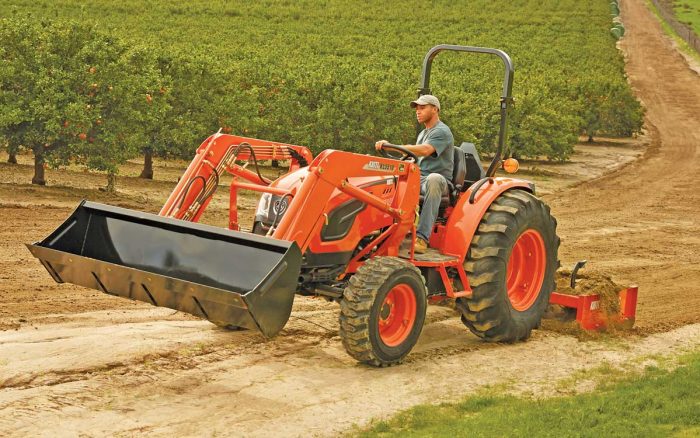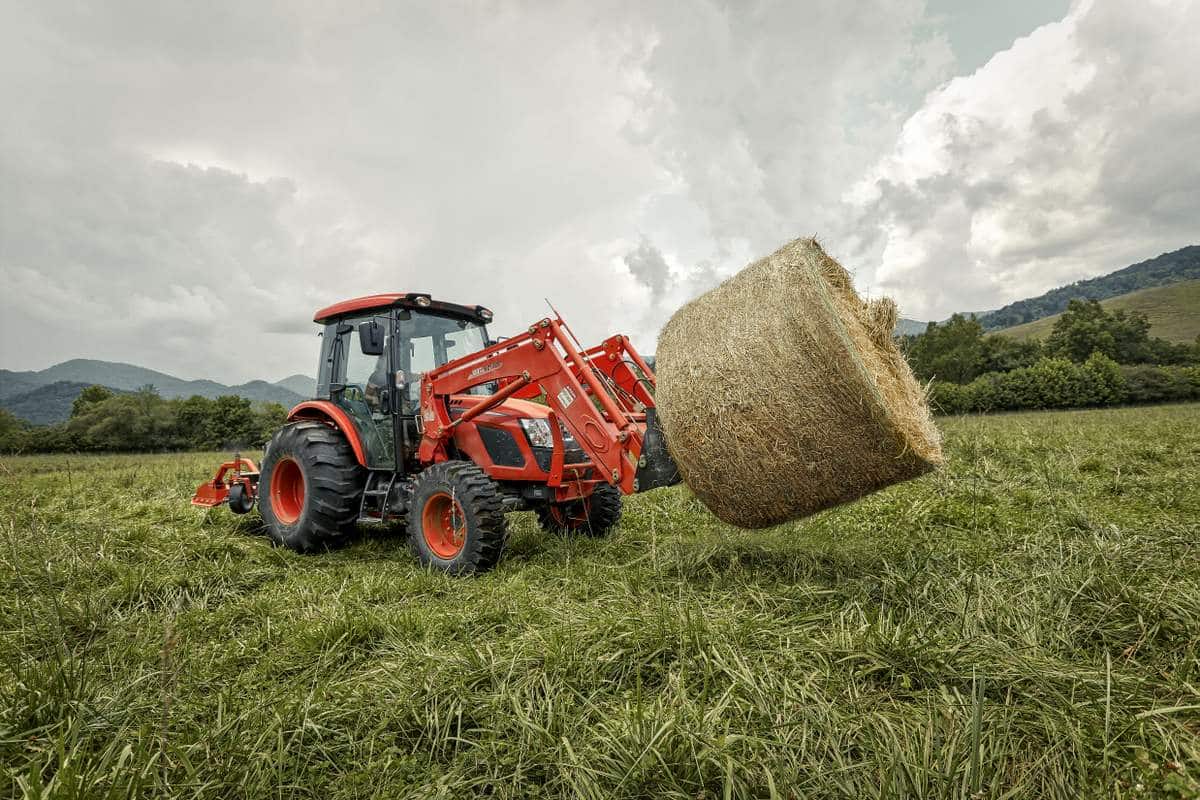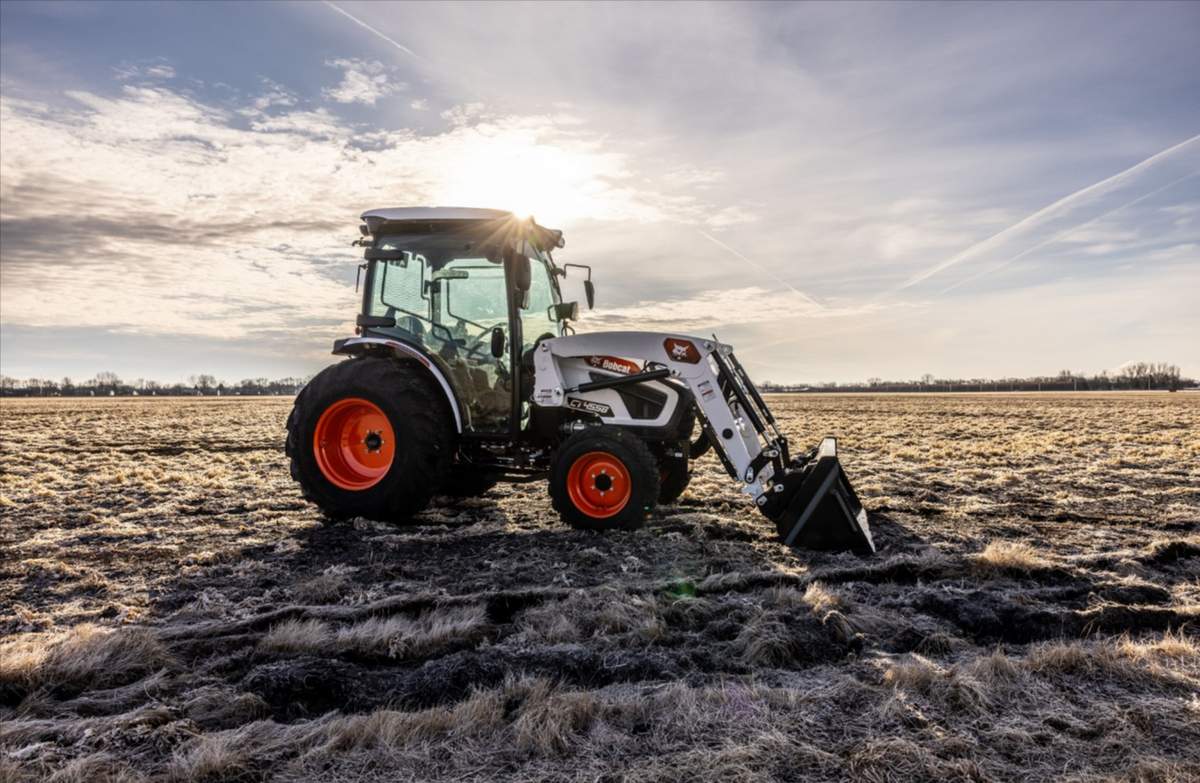Choices in Tires: Pick the Right Set of Wheels for Your Utility Tractor

No matter how advanced the technology in a compact utility tractor, it’s not going anywhere without tires. Tires can make or break the performance of a compact tractor by providing the proper traction, flotation and propulsion needed to achieve peak efficiency. Furthermore, worn treads or the wrong tires for the application can impede the productivity of a tractor. Swapping out tires is expensive and challenging because it often requires specialized equipment and expertise. Therefore, it’s advisable to select the right tires in the first place for optimal machine performance, and it’s just as important to maintain them in order to avoid tire failure and unscheduled downtime.
Types of Tractor Tires

According to Mark Davey, go-to-market manager for compact utility tractors at John Deere, the most common types of tires for compact utility tractors include:
- R1 agricultural tires — Ag tires feature a classic deep bar tread or lug design that has widely spaced aggressive treads designed for maximum traction in loose, soft or muddy soil. They are used in farming and other agricultural applications where maximum traction is needed, such as plowing, tilling, hauling manure and cultivating. Because they deliver more power to the ground, they are excellent for towing heavy loads and pulling implements.
- R3 turf tires — Turf tires feature a moderate bar or smaller, flatter lug design that is more closely spaced and less aggressive than R1 tires in order to minimize ground disturbance, making them suitable for landscaping, mowing and utility work in areas with established landscaping. They offer a balance between traction and smooth ride on hard surfaces and are capable of hauling and towing landscaping materials without disturbing the ground.
- R4 industrial tires — Industrial tires feature a wider tread than ag tires and a deeper lug design than turf tires for better traction on hard surfaces, such as pavement and rough terrain. As the toughest compact tire, capable of enduring wear while providing protection against punctures, they are a good choice for construction, material handling and road maintenance or other applications where the tractor transitions between different terrains. They provide superior traction for all ground conditions.
- R14 hybrid tires — These hybrid tires combine features of the R1 and R4, with a moderately spaced “lug” design that provides versatility for a wide range of applications, such as light construction, agriculture and landscaping.
“R14 tires are the new kids on the block and are gaining in popularity where compromises between traction and minimizing surface damage are acceptable,” Davey explains.
Joel Hicks, associate product line manager with Kioti Tractor, says hybrid tires provide traction like ag tires, combined with the durability and softer footprint of industrials. While industrial tires continue to be popular as an all-around tire, Hicks says the hybrids are gaining on them, due to their ability to provide better traction in a variety of environments. “Hybrids maintain good flotation when compared to industrial tires and a softer footprint when compared to agricultural tires,” he says.
Making the Choice

The tire categories are based on intended usage: turf, agricultural, industrial or multi-purpose. Most tread patterns are designed for specific tasks, so selecting the main functions will determine tire choice. But because most compact and small utility tractors are used in a variety of applications, customers usually make their choice of tire based on the highest typical usage.
“Consider the primary use of the tractor,” Davey suggests. “Ultimately, the decision all depends on the customer’s needs for their application.” For example, he says, industrial and construction applications may require R4 tires for better traction and durability. They are popular because they provide decent traction in dirt and mud while not being as aggressive as R1 tires on turf. R4 tire options typically have rigid sidewalls and the highest ply ratings, with some as high as 18 ply. Considerations beyond application include:
- Terrain — The R4 and R14 are well-suited for use on hard or paved surfaces, while the R1 and R3 are better choices for soft, muddy, turf or agricultural terrain, although Davey considers the less aggressive R3 turf tires better for sensitive surfaces and turf if you want a manicured look for the lawn.
- Versatility — The R14 is a good choice if the tractor will be performing a wide range of duties on a variety of terrain types.
- Cost — Tires with more aggressive treads are generally more expensive. That includes purchase price, fuel consumption and tire wear.
“Start by asking yourself what your overall use for the equipment looks like,” Hick advises. Be sure to consider the type[s] of environments you’ll be operating in and how traction and loading requirements may vary. Most compacts will utilize bias tires, whereas radial is increasingly more popular for larger tractors where traction, fuel economy and roadability are key factors in daily usage.”
Key Operational Techniques

Hicks believes that, in most applications, tires will last a long time when properly cared for because they don’t operate at high speeds and because compact and utility tractors are not usually on paved surfaces. Nevertheless, there are practices operators engage in that may prolong tire life. The first key operational technique is proper inflation, according to Davey. “Ensure the tires are inflated to the recommended pressure for the specific application. To increase traction and improve ride, reduce tire pressure. For increasing load-carrying capacity, inflate to near max pressure.”
It’s important, however, to avoid overloading. Excessive loads can cause premature wear and reduce traction. They may also cause mechanical damage to axles and other critical components. Inflation is a key factor, Hicks agrees. “Many people operate equipment with the tires underinflated, which can damage the tire and cause unusual wear.” He says most damage comes from overloading due to improper inflation or encounters with sharp objects like rocks, metal or roots.
In addition to maintaining proper inflation, minimizing exposure to sunlight can help keep the tires operating in top form well beyond the normal life expectancy of a car tire, Hicks mentions. Another important tip is to be certain you have proper ballasting. Ballasting the tractor correctly can improve traction and reduce tire slippage. Davey explains that ballast can be added through additional weights on the front or rear of the tractor on the wheels or by putting liquid ballast in the tires. Proper ballasting when pulling or lifting heavy loads will also help prevent unwanted tire slippage and deformation under heavy loads, Hicks concludes.
Common Tire Issues to Watch
One of the more common problems with tires is uneven wear, according to Mark Davey, go-to-market manager, compact utility tractors, John Deere. “You must address issues, such as improper inflation, misalignment or overloading and make sure you check to see if there are punctures [or] other harm to your tires. Regularly inspect them for any signs of damage and promptly repair or replace as needed.” Slow leaks or loss of air pressure over time is another common problem for operators. Joel Hicks, associate product line manager, Kioti Tractor, says most people only check the tire pressure if they notice an issue. “It is a good idea to make a habit of checking the pressure periodically.”
Reduce Tire Wear and Save Fuel

When it comes to saving fuel, Davey says the most important thing is to have smooth operation. “Avoid sudden acceleration, braking and sharp turns to help minimize tire wear and reduce your fuel consumption.”
Efficient driving habits are important. Operating the tractor at optimal speeds and rpm ranges can help save fuel and reduce tire wear. “When you’re on the highway or any hard surface, such as asphalt or concrete, be cautious how often you run your vehicle with four-wheel drive engaged. This is another way to reduce tire wear,” Davey counsels.
In addition to driving at a consistent speed whenever possible, Hicks urges operators to minimize idle time. He also advises them to maintain their tractor to operate efficiently and consume less fuel. That includes maintaining proper tire inflation, which he considers a key factor for saving on tire and fuel costs. “Be sure to check tire pressure and ensure it is at the recommended level on a regular basis.” Davey concludes with some final tips:
- Ensure you’re operating the vehicle at suggested speeds highlighted in the owner’s manual while transporting a load.
- It’s important that every operator complies with the correct tire combinations.
- Do not overload your tires and do not exceed maximum inflation pressure or maximum load capacity of your tires.
Lori Lovely is a freelance writer for Compact Equipment.
Tracking Tire Wear

Another best practice that can contribute to fuel savings is tracking tire wear. Regular inspections are critical in tracking tire wear. Performing a visual inspection to check treads for wear patterns or measuring with a tread depth gauge is sufficient. During an inspection, check for signs of wear, cuts or punctures and replace tires as recommended by your dealer or tire manufacturer. Upon completion of a visual inspection, experts recommend maintaining a log of tire conditions to keep track of wear over time. This helps determine when to schedule replacements. Best practices an operator should do include reviewing their machine’s tires to stay on top of tire pressure before every use. Stay on top of the tire rotation schedule. Additionally, the alignment of the tractor wheels should be checked periodically. Don’t forget to check the tightness of wheel hardware and maintain it according to service interval recommendations. Also, check the wheel bolt tightness and torque as necessary. Providing extra care and attention to detail along the way will help maintain peak performance from your tires.




